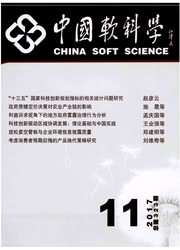

 中文摘要:
中文摘要:
促进科技与经济的结合一直以来是我国国家创新系统建设的核心主线。目前,有关中国国家创新系统的研究多是参照北美和欧洲的国家创新系统框架,分析创新系统的构成主体及互动关系,忽视了在系统演进过程中构成主体的功能变迁。本文从“巴斯德象限”理论出发,以中科院为研究对象,观察公立科研机构在创新政策激励下的功能变化,进而审视我国国家创新系统的建设绩效。研究通过问卷调研收集了中科院科研人员发表论文、申请专利以及与企业开展合作的相关数据,采用OLS进行回归分析,获得了一些新颖而重要的发现:首先,科学家的论文发表和专利申请具有显著正相关关系,那些发表论文较多的科学家同样也是申请专利较多的科学家。其次,对那些与产业有合作的科学家来说,其论文发表与专利申请之间的正相关关系更加显著。进一步的分类研究,还发现这一相关性受到科学家价值取向的调节。这些发现不仅为检验国家创新系统绩效提供了新视角,而且对创新政策设计有重要启示。
 英文摘要:
英文摘要:
The collaboration between science and industry has being the theme of building national innovation system (NIS) of China since Science and Technology System Reform At present, most studies of Chinese national innovation system are referring to the framework of NIS applying to North America and Europe that emphasizes the components of NIS, and neglect the change of these components in the process of the system building. Based on "Pasteur quadrant" theory, this paper examined the relationship of publishing and patenting within Ctfinese Academy of Sciences, which is to a large extent influenced by incentive policies. The authors collected the data of paper publication, patent application and collaboration with finns of sample scientists through a survey conducted in 2010 within Chinese academy of sciences. After regression analysis, the paper got some novel and important findings: firstly, the scientists with more paper publication also are the ones who applied for more patents; Secondly, for scientists those have cooperation with industry, the positive relationship between paper publication and patent application is more significant, while such relationship also moderated by the value orientation of scientists. These findings not only provide a new perspective to examine the performance of NIS, but also have important implications for innovation policy making.
 同期刊论文项目
同期刊论文项目
 同项目期刊论文
同项目期刊论文
 期刊信息
期刊信息
